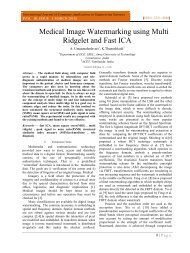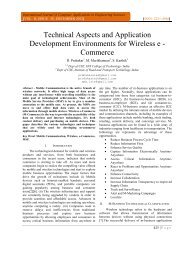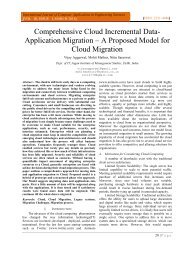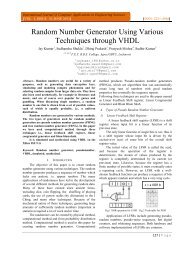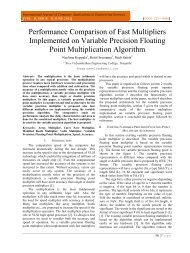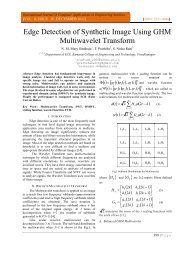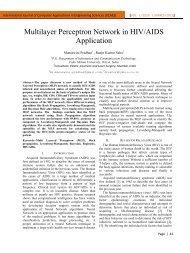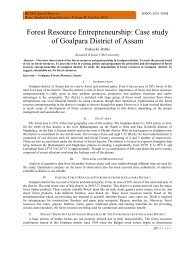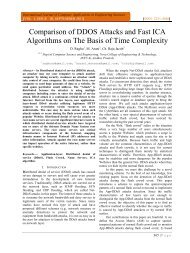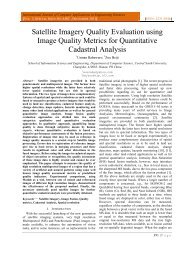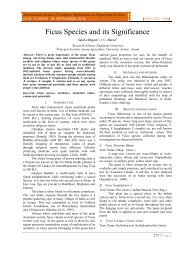Alienation, Maladjustment and the Search for Self-identity in Anita ...
Alienation, Maladjustment and the Search for Self-identity in Anita ...
Alienation, Maladjustment and the Search for Self-identity in Anita ...
You also want an ePaper? Increase the reach of your titles
YUMPU automatically turns print PDFs into web optimized ePapers that Google loves.
IJCAES SPECIAL ISSUE ONBASIC, APPLIED & SOCIAL SCIENCES, VOLUME II, JULY 2012[ISSN: 2231-4946]<strong>Alienation</strong>, <strong>Maladjustment</strong> <strong>and</strong> <strong>the</strong> <strong>Search</strong> <strong>for</strong><strong>Self</strong>-<strong>identity</strong> <strong>in</strong> <strong>Anita</strong> Desai’s Bye-ByeBlackbird, Baumgartner’s Bombay <strong>and</strong> Fast<strong>in</strong>g,Feast<strong>in</strong>g <strong>and</strong> Jhumpa Lahiri’s Interpreter ofMaladies <strong>and</strong> The NamesakeSapan NarzaryResearch Scholar, S<strong>in</strong>ghania University, RajasthanAbstract – Indian English Literature (IEL) can be appreciated as a collective ef<strong>for</strong>t on <strong>the</strong> body of work bynumerous native Indian writers of English language <strong>and</strong> whose native or co-native language could be oneof <strong>the</strong> several languages of India <strong>in</strong> creat<strong>in</strong>g a rare dist<strong>in</strong>ction <strong>in</strong> <strong>the</strong> <strong>in</strong>ternational literary scene. Thus,Indian English Literature (IEL) can be identified as all <strong>the</strong> production of literary writ<strong>in</strong>gs of Indianwriters <strong>in</strong> <strong>the</strong> English language that has made significant contributions to World literature, both <strong>in</strong> <strong>the</strong> pre<strong>and</strong> post <strong>in</strong>dependence era. The term is also popularly associated with <strong>the</strong> works of members of <strong>the</strong> literarycreation of Indian writers who are considered <strong>the</strong> ‘Indian Diaspora’, such as V. S. Naipaul, Kiran Desai,Jhumpa Lahiri <strong>and</strong> Salman Rushdie. Sometimes, it is dist<strong>in</strong>ctively referred to as Indo-Anglian literaturethat has a specific term <strong>in</strong> <strong>the</strong> sole context of writ<strong>in</strong>g <strong>and</strong> should not be confused with <strong>the</strong> term Anglo-Indian.Keywords – Romance, English, India, novel.I. INTRODUCTIONIndian Writ<strong>in</strong>g <strong>in</strong> English (IWE) refers collectively to <strong>the</strong> work of Indian writers writ<strong>in</strong>g <strong>in</strong> <strong>the</strong> English languageboth dur<strong>in</strong>g <strong>the</strong> pre <strong>and</strong> post Independent India. English, though a <strong>for</strong>eign language, became popular amongst <strong>the</strong>Indians as a means of communicat<strong>in</strong>g with <strong>the</strong> outside world. But it rema<strong>in</strong>ed elitist to a large extent. EducatedIndians who communicated <strong>in</strong> English <strong>and</strong> much less, wrote books <strong>in</strong> English were few. Rab<strong>in</strong>dranath Tagore,Jawaharlal Nehru, Dr. S. Radhakrishnan, Mulk Raj An<strong>and</strong>, R.K. Narayan etc. were among <strong>the</strong> noteworthy oneswhose pen took <strong>the</strong> voice of India to <strong>the</strong> outside world. Post Independent India saw <strong>the</strong> emergence of a new crop ofcreative writers whose writ<strong>in</strong>gs brought <strong>in</strong> a whiff of fresh air <strong>in</strong>to <strong>the</strong> literary scene <strong>and</strong> lent an Indian touch to <strong>the</strong><strong>the</strong>mes <strong>and</strong> treatment. Writers like Salman Rushdie, Amitav Ghosh, Vikram Seth, <strong>Anita</strong> Desai, Nayantara Sehgal,Arundhati Roy, Jhumpa Lahiri <strong>and</strong> Kiran Desai made <strong>the</strong> whole world sit up <strong>and</strong> take notice of <strong>the</strong>ir dist<strong>in</strong>ctiveIndian <strong>the</strong>mes <strong>and</strong> style.In <strong>the</strong> Indian literary scene, women writers have done exceptionally well. Storytell<strong>in</strong>g has always been women’s<strong>for</strong>te. If Europe’s lum<strong>in</strong>aries were Jane Austen, George Eliot, Charlotte Bronte, Emily Bronte, Mrs. Gaskell,Dorothy Richardson, Virg<strong>in</strong>ia Woolf, India’s are Toru Dutt, Kamala Mark<strong>and</strong>aya, Attia Hosa<strong>in</strong>, Ruth PrawerJhabvala, <strong>Anita</strong> Desai, Nayantara Sehgal <strong>and</strong> Shashi Deshp<strong>and</strong>e among <strong>the</strong> old order.II.METHODOLOGY‘Romance’ was one of <strong>the</strong> easiest subjects <strong>in</strong> <strong>the</strong> h<strong>and</strong>s of women writers. It provided <strong>the</strong>m a way out from <strong>the</strong>harsh <strong>and</strong> stark realities of life. Toru Dutt’s Bianca or The Young Spanish Maiden (1878) <strong>and</strong> Le Journal deMademoiselle d’Arvers (1963) is one of <strong>the</strong> earliest works on this <strong>the</strong>me. Slowly, <strong>the</strong> trend turned towards‘Realism’. Serious ef<strong>for</strong>ts were made towards a realistic depiction of society. Themes became more universal <strong>and</strong>women-oriented entail<strong>in</strong>g a more sympa<strong>the</strong>tic treatment by women writers. The women writers of this period to<strong>the</strong>ir credit could hold <strong>the</strong>ir own <strong>and</strong> make <strong>the</strong>ir voices heard <strong>and</strong> concerns felt even <strong>in</strong> <strong>the</strong> hi<strong>the</strong>rto purely maledom<strong>in</strong>atedliterary world.III.ABOUT WRITING156 | P a g e
<strong>Alienation</strong>, <strong>Maladjustment</strong> <strong>and</strong> <strong>the</strong> <strong>Search</strong> <strong>for</strong> <strong>Self</strong>-<strong>identity</strong> <strong>in</strong> <strong>Anita</strong> Desai’s Bye-Bye Blackbird,Baumgartner’s Bombay <strong>and</strong> Fast<strong>in</strong>g, Feast<strong>in</strong>g <strong>and</strong> Jhumpa Lahiri’s Interpreter of Maladies <strong>and</strong> TheNamesakefeels <strong>the</strong> immigrants’ sense of nostalgia <strong>and</strong> yearn<strong>in</strong>g <strong>for</strong> <strong>the</strong> country of <strong>the</strong>ir orig<strong>in</strong>. In <strong>the</strong> alien world, <strong>the</strong>differences between be<strong>in</strong>g an Indian, a Pakistani or a Bangladeshi does not matter. The basic po<strong>in</strong>t is stick<strong>in</strong>g it outtoge<strong>the</strong>r.The Namesake is thoroughly enmeshed <strong>in</strong> <strong>the</strong> ‘o<strong>the</strong>rness’ syndrome from beg<strong>in</strong>n<strong>in</strong>g to <strong>the</strong> end. It is <strong>the</strong> story of aBengali couple, Ashok Ganguli <strong>and</strong> Ashima who successfully make out a home <strong>for</strong> <strong>the</strong>mselves <strong>in</strong> America but wear<strong>the</strong>ir hearts on <strong>the</strong>ir sleeves <strong>for</strong> <strong>the</strong>ir homel<strong>and</strong>, India. Their children, Gogol <strong>and</strong> Sonia have problems with <strong>the</strong>ir<strong>identity</strong>. They do not feel at home <strong>in</strong> Calcutta where <strong>the</strong>y go <strong>for</strong> <strong>the</strong>ir holidays but are at ‘home’ <strong>in</strong> America. The‘o<strong>the</strong>r’ syndrome does not assail <strong>the</strong>m at all as it does <strong>the</strong>ir parents who do not regard America <strong>the</strong>ir ‘home’ evenafter twenty years of liv<strong>in</strong>g <strong>the</strong>re. But it does not stop <strong>the</strong>m from be<strong>in</strong>g marg<strong>in</strong>alized among <strong>the</strong>ir American friends.Perhaps this feel<strong>in</strong>g of marg<strong>in</strong>alization stems from a sense of <strong>in</strong>security.IV. CONCLUSIONThus, we see how <strong>the</strong> subjects of displacement, maladjustment <strong>and</strong> <strong>the</strong> search <strong>for</strong> self-<strong>identity</strong> <strong>for</strong>m <strong>the</strong> crux of<strong>the</strong> above cited works of <strong>the</strong>se two women writers. It will be <strong>in</strong>terest<strong>in</strong>g to focus on <strong>the</strong> treatment of <strong>the</strong> <strong>the</strong>mes <strong>in</strong>both <strong>the</strong> writers. The search <strong>and</strong> need <strong>for</strong> self-<strong>identity</strong> is more acute <strong>in</strong> today’s world of diverse cultures. Strangelyenough, even as we move on towards a more globalised universe, <strong>the</strong> more <strong>the</strong> <strong>in</strong>ability to adjust or tolerate <strong>the</strong>‘o<strong>the</strong>r’ one. I f<strong>in</strong>d ample scope <strong>for</strong> extensive research on this subject <strong>and</strong> as such have chosen it as <strong>the</strong> topic of myresearch work.REFERENCES[1] Iyengar, K.R. Sr<strong>in</strong>ivasa: Indian Writ<strong>in</strong>g <strong>in</strong> English, Sterl<strong>in</strong>g Publishers Private Ltd., New Delhi, 2002.[2] ed. Datta, Ketaki: Indo-Anglian Literature: Past to Present, Books Way, Kolkata, 2008.[3] ed. Prasad, Amar Nath: New Lights On Indian Women Novelists <strong>in</strong> English, vol-IV, Sarup & Sons, New Delhi, 2008.[4] ed. Rushdie, Salman <strong>and</strong> West, Elizabeth: The V<strong>in</strong>tage Book of Indian Writ<strong>in</strong>g 1947-1997, V<strong>in</strong>tage, Great Brita<strong>in</strong>, 1997.[5] ed. Pranad, Amar Nath: Critical Response to Indian Fiction <strong>in</strong> English, Atlantic Publishers <strong>and</strong> Distributors, New Delhi, 2001.[6] S<strong>in</strong>ha, Sunita: Post Colonial Women writers New Perspectives, Atlantic Publishers <strong>and</strong> Distributors (P) Ltd., New Delhi, 2008.[7] Lahiri, Jhumpa: The Namesake, HarperColl<strong>in</strong>s Publishers India, New Delhi, 2004.[8] Lahiri, Jhumpa: Interpreter of Maladies, stories of bengal, boston <strong>and</strong> beyond, HarperColl<strong>in</strong>s Publishers India, New Delhi, 1999.[9] Desai, <strong>Anita</strong>: Bye-Bye Blackbird, Orient Paperbacks, New Delhi, 2007.[10] Desai, <strong>Anita</strong>: Baumgartner’s Bombay, R<strong>and</strong>om House India, New Delhi, 2007.158 | P a g e



